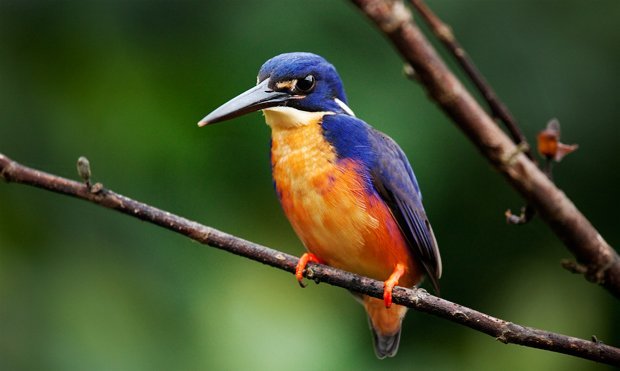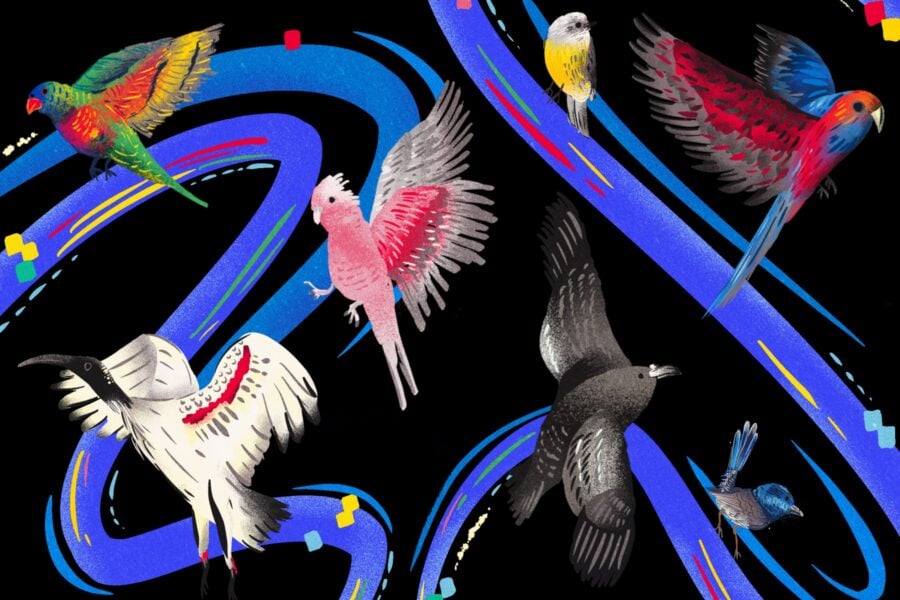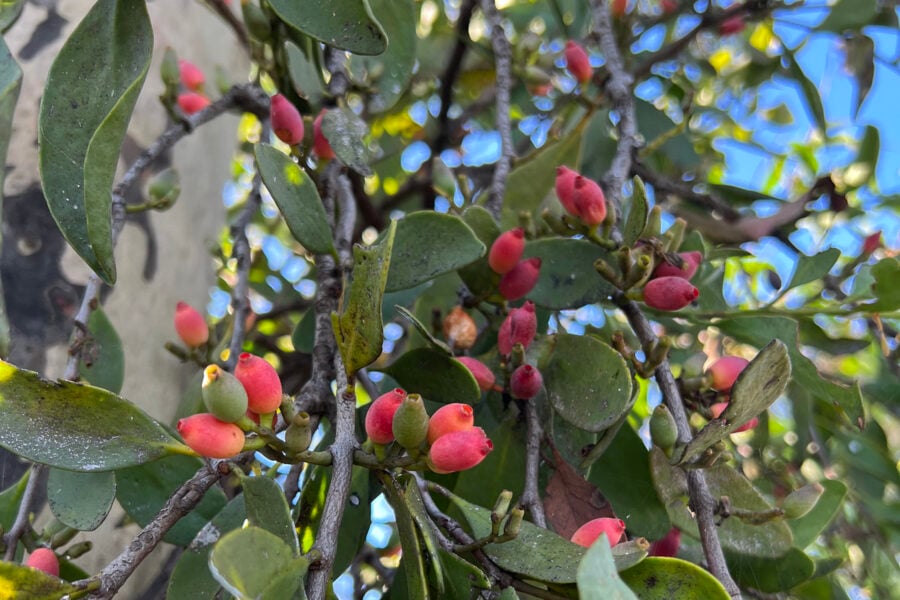Bird watcher’s guide to Australia

THERE’S A GIANT POT of sword ferns outside my home office with a nest in it. If I lean back from the keyboard and peek through a gap in the venetians, the beady eye of a female common blackbird stares right back at me. She’s sitting on four eggs, milky green and speckled brown, each not much bigger than a macadamia nut. Whizbang broadband might promise the world but the family drama unfolding a metre from my computer is far more compelling.
I’m not a ‘birdwatcher’. I don’t keep lists or seek out the rarest of the rare. But I’m endlessly grateful that we live close to the bush and are always in feathered company. They chortle away, alight on bushes and stick their beaks into flowers and fruit. We have tribes of wrens, honeyeaters and thornbills claiming ownership of the garden. I wake to rosellas, lorikeets and screeching galahs. Even after many years the mere glimpse of yellow-tailed black-cockatoos lumbering through the air still stops me in my tracks.
Little by little, I’ve surrendered to various demands. Birdbaths have been installed, a feeder hangs in the apple tree for the red-browed finches and flowery shrubs have been planted to appease the eastern spinebills. In return, our many tenants strut their stuff, sing their hearts out and show what it means to get on with life.
Bird watching: A beginning
Surprise encounters over the years have made me an accidental birdo. There was the time I was in Witjira National Park, SA – a land of sprawling plains studded with gibber, each chocolate-red pebble fired with its desert glaze. In this big-sky country any scrap of life, even a withered grass tussock or humble saltbush, appears like a miracle. We drove all afternoon across the cobbled rises, squinting into the emptiness till at last a creek-line beckoned.
Under shady coolibahs we unfurled our swags. Wandering along the creek on dusk I stumbled across a bathtub-sized puddle of murky water, the remnants of a rainstorm perhaps a week or two earlier. Then, in the distance, a long swirl of green, like a trailing scarf, appeared in the sky low on the horizon. It dipped and rose before I twigged that this cloud had wings – thousands of them – belonging to a huge flock of wild budgies. They swooshed past me in a chattering rush and disappeared into the dusty sky.
I’ll never know what these birds were gabbling about, but they were like an emblem of the desert. One minute nothing; the next, a startling abundance.
On Cabbage Tree Island, NSW, after a night of thunder and wailing birds, I scrambled up a steep ramp of rainforest to the tiny isle’s northern tip. The island is the only breeding ground for the Gould’s petrel, one of the world’s rarest seabirds, however this morning it was time for a break from their chaotic nesting gullies. Humid air floated through the forest, rattling the dry cabbage-palm fronds. But there was another sound, like a box of matches being dropped. Looking up into the canopy of a big sandpaper fig I saw round fruit falling, then a flash of purple and gold on the plump belly of a wompoo fruit-dove, the crown-prince of pigeons.
These sudden visions feel like gifts. Months earlier I was alone in rainforest on an island off the northern Kimberley coast. Feeling overwhelmed by the place and just a little jaded, I retreated to a rock outcrop. After nodding off in the shade I woke to find wompoo’s cousin, the gloriously coloured rose-crowned fruit-dove, peering down from the vines above – truly a sight for sore eyes.
On the other side of the country sprawls another rainforest: Lamington National Park, a snarl of vines and moss-draped Antarctic beech trees clustered along the border of Queensland and NSW. There should have been views, but a creamy mist hung in the forest as the trees worked like velcro to snag every passing cloud. So much history here. So much that seemed unfamiliar and unknowable. But then the shadowy stillness was split by birdsong, a bubbling torrent of notes, mimicry and cries so strong they echoed in my chest. In that moment, the spirit and antiquity of the place coalesced in the joyful song of the Albert’s lyrebird.
Bird watching: Close to home
They say travel broadens the mind. But keep on travelling and soon you have all breadth and no depth. Incidents pile up with fleeting scenes and fragments of places. You look for a way in – or a way out. As the years go by I find myself following the birds. They are born storytellers. Their lives give us narratives we can hang on to, ones rich in striving and mateship, song and dance, homemaking and family life. They tell you a lot about where you are.
In bird terms, my spouse Dale and I are mostly sedentary, though seasonally nomadic. But flitting about the fleshpots of Byron Bay, NSW, we are way out of our normal range. Big haciendas and flash resorts, arty boutiques and the motley surfing crowd is not familiar habitat.
When the confusion gets too much we skulk to the beach or, better still, the rainforest. There we are happy to be vagrants, listening to the chatter and musical trills from the trees. Alas, one resident – the whipbird – makes a hash of it with his raucous whip-cracking shout. Still, I can relate to that. As American poet Henry Van Dyke said: “Use what talents you possess; the woods would be very silent if no birds sang except those that sang best.”
There’s a breed of person that lives to spot birds – to take notes, record calls and keep lists. I’m too indisciplined a traveller to be either a twitcher or champagne birder, but over the years birds have wheedled their way into my thinking. I’m not the only one, it seems – Australians all over have begun flocking toward the sewage farms on the doorsteps of their cities and towns, lured by the jaunty, cackling characters that never fail to put on a show.
In the end it’s always the birds themselves who win me over. They’re always out there, taunting me with their banter, flashy garb and aerial high jinks. One by one they have taught me to look and listen – and enjoy.
BIRD OBSERVATORIES
Visits to these observatories must be booked in advance.
Eyre Bird Observatory, WA
Around one-third of Australia’s total bird species can be seen here. Visitors can stay at the observatory and take part in a number of volunteer programs, including banding and birdcounts. www.eyrebirds.org
Gluepot Reserve, SA
There are 181 species on Gluepot Reserve’s bird list, including the largest remaining population of endangered black-eared miners. Visitors can camp here, but must be self-sufficient. www.riverland.net.au
Broome Bird Observatory, WA
This is one of the best sites in the world for migratory waders. Visitors can camp or stay in the self-contained chalet.
www.broomebirdobservatory.com
Newhaven Sanctuary, NT
Newhaven protects about 140 species of birds. There’s a camping ground with toilets and showers; visitors must be
self-sufficient. Open April-October.
www.awc.org.au/newhaven.asp
RELATED STORIES




